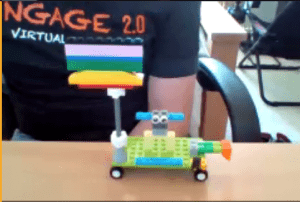We don’t hate online meetings – we hate soul-sucking wastes of time.
After months of online meetings, video conferences, Zoom, and Teams meetings, you’ve mastered the basics:
- You’ve got light in front of you (not behind you) so we can see you.
- You look into the camera to connect with your team.
- You’ve got a list of everyone attending and you call in each person to take part.
- You found a decent microphone so your team can hear you and you don’t have to yell.
- You invite the least number of people to make the best decisions.
- At the beginning of the meeting, you summarize the purpose.
- Your agenda is short, snappy, and people don’t drift and start checking emails.
- At the end of the meeting, you check for understanding and schedule the finish by asking “Who’s doing what, by when, and how will we know?”
- And, vitally, you’re not holding a video meeting when a phone call or email will do.
You’re doing these things, but online meeting fatigue persists. What now?
Why Online Meetings Wear Us Out
Online meeting fatigue is real. There are a couple of reasons it happens and, when you know why, you can do something about them.
Remote Energy Drains – It takes energy to look into that camera and convey your support, encouragement, urgency, or concern. And then, you’re putting that energy into the camera, but you don’t get it back.
Your brain is built to work with the verbal and nonverbal cues you get from other people. Without those cues, you spend more energy in the form of anxiety, trying to figure out what’s happening. Much of this is unconscious, but it’s happening and it wears us out.
Seeing Yourself – Imagine a traditional face-to-face team meeting. Now imagine holding a mirror in front of your face while you’re talking. You would become hyper-aware of your facial expressions, posture, the tilt of your head, that fly-away hair that won’t behave, asking yourself “Should I move that way, no-wait-I’m-mirrored-go-the-other-way. Oh dang, that looked dumb, argh …” the list goes on.
The default “see-yourself” settings in many video meeting platforms create new awareness. For some of us, this isn’t bad—we needed the help. But this awareness of yourself consumes yet more energy – energy you never had to expend in a face-to-face setting.
People Become Less Human – One of the challenging aspects of our humanity is that it’s easier to see people close to us as fully formed persons with complex lives and a range of interests. The farther away a person is, the easier it is to reduce them to their role, a number, or even a problem. Online meetings can reinforce this tendency if we’re not careful. (Fortunately, they can also help to humanize one another if we’re intentional about it.)
How to Invigorate Your Online Meetings
Get Personal – One of the most effective and easiest ways to reinvigorate your online meetings is to show up with (and invite others’) full humanity. You can set a different tone and create meaningful connections by starting with the people, rather than the business.
Get past the friendly banter and start with meaningful, but safe, self-disclosure. For example:
- Ask everyone to share an inspirational quote that’s guided them through challenging times.
- Have every participant show an object that is meaningful to them and explain why.
- For a lighter tone, you might start by asking everyone to share the most humorous regret they have during the pandemic.
Add Drama – What made Tiger King such an early pandemic phenomenon? Perhaps it was the lack of new alternatives, but at its core, that show had drama. (I wasn’t a fan of the show, but every minute had you wondering “What the heck will happen next?”)
 Now, I’m not suggesting you threaten your competition or accuse a colleague of murdering their spouse (and if those references don’t mean anything to you – you didn’t watch the show, and that’s perfectly okay)—but, you can add drama to your meetings and make them more interesting.
Now, I’m not suggesting you threaten your competition or accuse a colleague of murdering their spouse (and if those references don’t mean anything to you – you didn’t watch the show, and that’s perfectly okay)—but, you can add drama to your meetings and make them more interesting.
There are several ways to amp up the intrigue, drama, and curiosity.
Start by making interesting decisions. Start a decision-making discussion with a clear definition of what’s at stake, why the decision matters, and what their choice will accomplish.
Not making a decision? Use a classic pre-commercial television technique: the teaser. “When we return, will our hero save the day or will she face crushing failure?”
In a business meeting this might look like, “Today we’re discussing a new process that will reduce our headaches and give us a chance to catch up on …” Assuming you’ve told the truth and the process really does those things, now I’m leaning in, paying attention, and wanting to get to the good stuff.
Another fun way to add dramatic tension is to use tools like the Wheel of Names to review content, summarize action items, check for understanding, or choose someone to answer questions. You don’t want to overuse it, but people almost hold their breath waiting to see where the needle lands.
Finally, you’ll introduce more drama as you vary the other techniques in this article. Your team will constantly wonder what might happen next. That positive anticipation alleviates fatigue and boredom.

avoid online meeting fatigue by integrating activities
Collaborate – One of the best advantages of online meetings is the ability to collaborate quickly, discuss critical questions, and regroup to share analysis, conclusions, and solutions. We’ve been so proud of the speed with which large teams can quickly identify strategic solutions and move to action when given the chance.
Use your breakout rooms, whiteboard tools, collaboration platforms like MIRO, and your public chat room to take advantage of all the thought-power on your team.
Bottom line: if you hold a meeting and don’t have participants talking with one another about critical issues, you’re wasting everyone’s time.

using tools and desk items at hand, along with interactive activities to keep people engaged and moving
Think Outside the Screen – It’s only natural – we zero in on the camera lens with an occasional glance at the video images on the screen. Before long, your world—and the world of your teammates—has shrunk to the rectangle in front of you.
Ease online meetings fatigue by thinking outside the screen.
- Get people moving. Stand up. Dance.
- Have a yoga practitioner on your team? Have them lead a 60-second yoga break.
- Do an agenda-related scavenger hunt – “In 30 seconds, find an item that best illustrates [the problem we’re addressing] or [the future we want to achieve].”
- Communicate key messages outside the screen in ways no one will expect (check out this article for a fantastic list of ways to communicate off-screen.)
Build, draw, tear—almost anything you’d do in person, you can adapt for remote meetings.
Remove Energy Drains – Once you’ve got your camera set up and you know you framed your backdrop the way you want it, in many platforms, you don’t have to keep looking at yourself. Here’s how to hide your video from yourself in Zoom.
What about that energy drain of not getting reactions?
Depending on your platform, you can use thumbs up, claps, emojis, chat responses, or visual cues (think jazz hands) for real-time feedback. Create a culture of engagement and people will naturally interact with one another’s comments, feedback, and presentations. No, this doesn’t replace the real-time nonverbal signals we’re accustomed to, but over time it will help.
Your Turn
Some of the most fun moments over the past few months have been talking with leaders about the fun and creative ways they run meetings and engage their teams. We’d love to keep that spirit of creativity, fun, and team engagement going here.
Leave us a comment and share: What is your best suggestion to alleviate online meeting fatigue?
See Also:
Virtual One-on-One Meetings: How to Build a Better Virtual Connection








Great insights on managing online meetings! I’ve found that adding interactive elements can really help keep participants engaged. A tool like the Random Name Picker adds a fun element to choosing who’s next to speak, which often livens up the atmosphere and keeps everyone alert. It’s a small change but makes meetings feel more dynamic.
Thanks Monica! Engagement is everything.